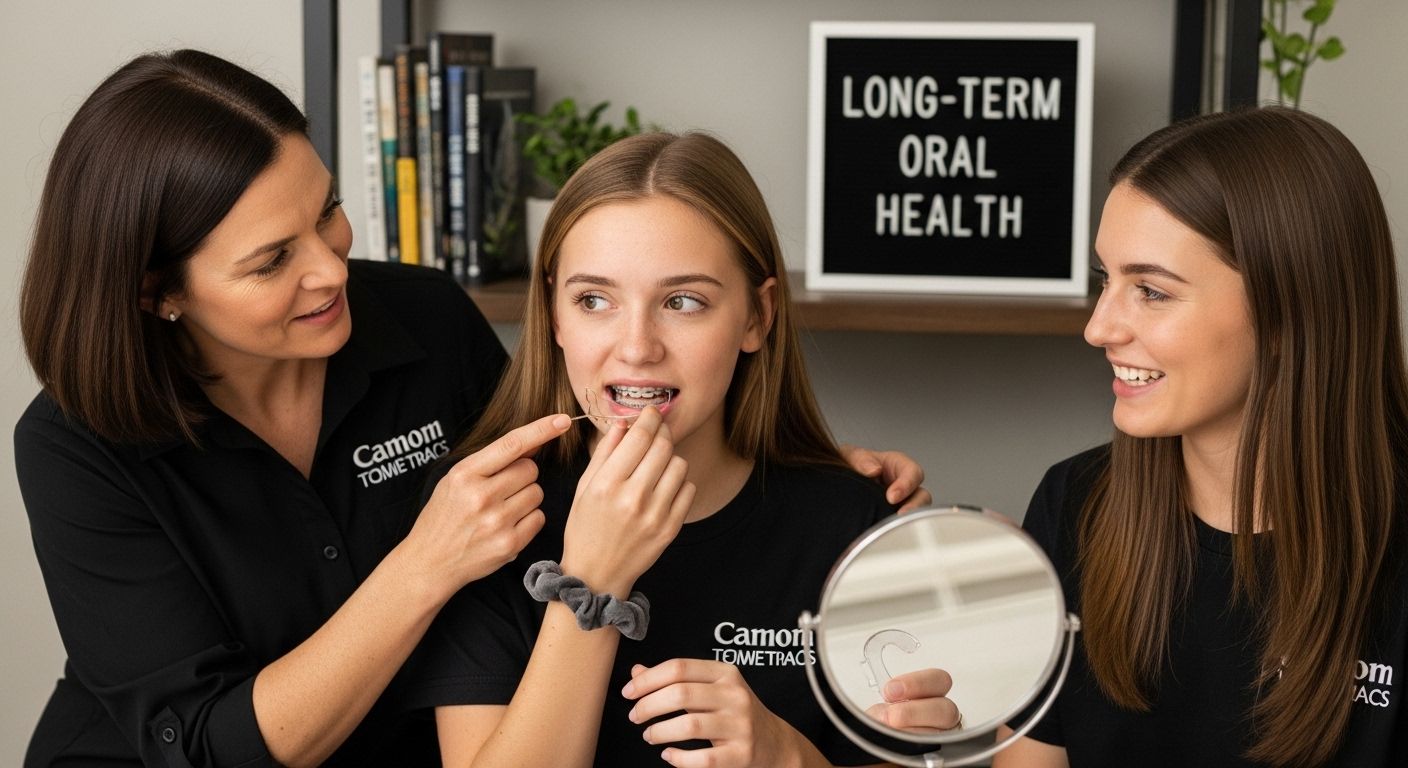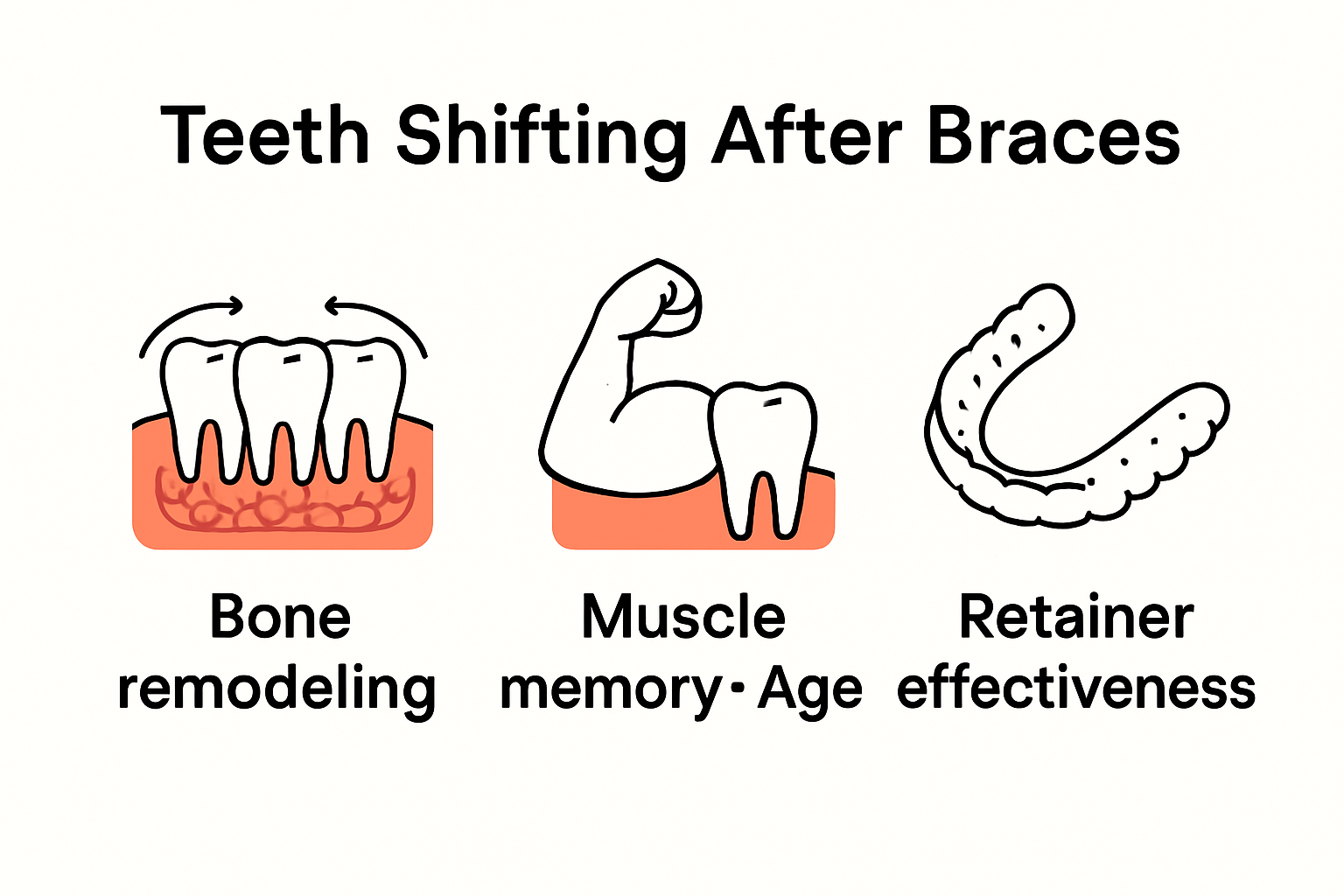Understanding Teeth Shifting After Braces: Key Insights
August 23, 2025
Understanding Teeth Shifting After Braces: Key Insights
Teeth shifting after braces catches many people off guard, even after years of careful orthodontic treatment. But here is something most people miss. Studies show that teeth can start moving back toward their original spots as soon as a few weeks after braces are removed. Forget the idea that your new smile is set in stone the moment the brackets come off. The real challenge is how your teeth keep fighting to return to their old positions no matter how straight they look at first.
Table of Contents
- What Are Teeth Shifting After Braces?
- Why Does Teeth Shifting Happen After Orthodontic Treatment?
- The Biological Basis Of Teeth Movement And Retention
- Impact Of Teeth Shifting On Long-Term Oral Health
- Managing Teeth Shifting: Understanding Retainers And Beyond
Quick Summary
| Takeaway | Explanation |
|---|---|
| Teeth shift naturally post-treatment | After braces, teeth can move back towards their original positions due to biological processes. |
| Bone remodeling affects stability | Ongoing adaptation of the jawbone significantly influences how teeth remain aligned after braces are removed. |
| Retainers are essential for maintaining alignment | Wearing retainers helps keep teeth in their corrected positions, minimizing the risk of unwanted shifting. |
| Age plays a crucial role in shifting | Younger patients may experience more pronounced teeth movement post-treatment due to ongoing facial development. |
| Proactive monitoring is key for long-term health | Regular dental check-ups and personalized retention strategies help prevent complications from teeth shifting. |
What Are Teeth Shifting After Braces?
Teeth shifting after braces is a natural biological process where teeth gradually move from their corrected orthodontic position back towards their original alignment. This phenomenon occurs due to complex interactions between bone, muscle, and dental structures that continue to evolve even after orthodontic treatment concludes.
To help you better understand why teeth tend to shift after braces, here is a comparison of the main biological mechanisms driving this process.
| Mechanism | Description |
|---|---|
| Biological Memory | Periodontal ligaments recall original tooth positions and may pull teeth back towards those spots after braces are removed. |
| Bone Remodeling | Jawbone structure continuously adapts to new dental positions through bone resorption and formation, affecting stability. |
| Muscular Pressure | Forces from the tongue, cheeks, and jaw movements subtly influence teeth alignment and can prompt movement over time. |
| Soft Tissue Tension | Elasticity of surrounding gums and tissues can encourage teeth to shift from their corrected positions. |
| Facial Growth | Ongoing jaw and facial development, especially in younger patients, contributes to post-treatment shifting. |
Understanding the Biological Mechanism
After braces are removed, teeth do not instantly become permanently fixed in their new positions. Instead, the surrounding periodontal ligaments and bone require significant time to stabilize and support the new dental alignment. Research from the National Center for Biotechnology Information reveals that maintaining teeth in their corrected positions is challenging due to multiple physiological factors.
The shifting process involves several key biological mechanisms:
- Natural muscle memory and soft tissue tension
- Ongoing jaw and facial bone growth
- Continuous pressure from tongue and bite dynamics
- Age-related dental changes
Factors Influencing Tooth Movement
Multiple factors contribute to teeth shifting after orthodontic treatment. Bone remodeling plays a critical role in this process, where the jawbone continuously adapts to changing dental positions. Muscular forces from speaking, chewing, and even sleeping can subtly influence tooth alignment.
Age is another significant determinant. Younger patients might experience more pronounced shifting due to ongoing facial development, while adults might see more stable results. Genetic predispositions and individual physiological characteristics also impact the likelihood and extent of tooth movement.
To minimize unwanted shifting, orthodontic professionals typically recommend wearing retainers. These custom-designed appliances help maintain the corrected dental alignment by providing consistent structural support during the critical stabilization period.
Why Does Teeth Shifting Happen After Orthodontic Treatment?
Teeth shifting after orthodontic treatment results from complex biological mechanisms and ongoing physiological changes within the oral environment. Understanding these intricate processes helps patients recognize why maintaining dental alignment requires continuous attention and proactive management.
Biological Memory and Tissue Adaptation
The human mouth operates as a dynamic system where tissues continuously respond to internal and external forces. According to research from the Journal of International Society of Preventive & Community Dentistry, periodontal ligaments possess inherent “biological memory” that can cause teeth to gradually revert toward their original positions.
Key factors driving teeth shifting include:
- Residual muscular tension from pre-treatment positioning
- Persistent soft tissue elasticity
- Natural bone remodeling processes
- Ongoing facial growth and development
Underlying Physiological Forces
Muscular pressure plays a significant role in teeth shifting. The tongue, cheek muscles, and jaw movements exert continuous forces that can subtly influence dental alignment. These microscopic movements accumulate over time, potentially causing teeth to migrate.
Genetic predispositions also contribute substantially to post-orthodontic tooth movement. Some individuals have more elastic periodontal tissues or more dynamic bone remodeling processes, making them more susceptible to dental repositioning.
Age represents another critical factor. Younger patients experiencing ongoing facial development might encounter more pronounced teeth shifting compared to adults with more stable physiological structures. The constant interplay between muscular forces, bone growth, and tissue elasticity creates an environment where dental positioning remains dynamically responsive.
The Biological Basis of Teeth Movement and Retention
Teeth movement is a sophisticated biological process involving intricate interactions between mechanical forces, cellular responses, and tissue remodeling. Understanding these complex mechanisms provides insight into how orthodontic treatments create lasting dental transformations.
Mechanical Stimulation and Cellular Response
Research from the Journal of Dental Research reveals that tooth movement initiates a remarkable cascade of biological events within the periodontal environment. When mechanical forces are applied, specific cellular mechanisms activate, triggering controlled bone remodeling and tissue adaptation.
Key biological components involved in teeth movement include:
- Mechanical stress transmission through periodontal ligaments
- Inflammatory response activation
- Cellular signaling pathways
- Bone resorption and formation processes
Cellular Mechanisms of Tooth Repositioning
Osteoclast and osteoblast activities are fundamental to understanding tooth movement. These specialized cells work in concert to reshape bone tissue, creating spaces and generating pressure that allow teeth to migrate. When orthodontic forces are applied, localized areas of compression and tension emerge, stimulating different cellular responses.
In compression zones, osteoclasts become activated, breaking down bone tissue and creating pathways for tooth movement. Simultaneously, tension zones prompt osteoblasts to deposit new bone material, stabilizing the tooth in its emerging position.
Genetic factors and individual physiological characteristics significantly influence the efficiency and speed of these biological processes. Some individuals experience more rapid tooth movement due to more responsive cellular mechanisms and robust bone remodeling capacities.
Impact of Teeth Shifting on Long-Term Oral Health
Teeth shifting is not merely a cosmetic concern but a significant factor that can substantially influence overall oral health and functionality. The progressive movement of teeth after orthodontic treatment can trigger a cascade of potential dental complications that extend far beyond aesthetic considerations.
Structural and Functional Consequences
Research from the National Institutes of Health highlights the profound implications of post-orthodontic tooth movement on long-term oral health. Uncontrolled teeth shifting can compromise dental structural integrity and create systemic challenges within the oral ecosystem.
Potential long-term health risks associated with teeth shifting include:
- Increased periodontal instability
- Higher susceptibility to dental decay
- Compromised bite alignment
- Potential jaw joint dysfunction
- Accelerated enamel wear
Biomechanical and Physiological Implications
Bite misalignment represents one of the most significant consequences of unaddressed teeth shifting. When teeth migrate from their corrected positions, the entire biomechanical system of mastication becomes disrupted. This disruption can lead to uneven pressure distribution during chewing, potentially causing:
Jaw muscle strain, temporomandibular joint stress, and increased risk of developing chronic orofacial pain syndromes. The delicate balance of dental occlusion depends on precise tooth positioning, and even minor shifts can trigger substantial physiological adaptations.

Genetic predispositions and individual physiological characteristics further complicate the potential health impacts. Some individuals may experience more pronounced effects from teeth shifting, underscoring the importance of personalized dental monitoring and proactive retention strategies.
Managing Teeth Shifting: Understanding Retainers and Beyond
Managing teeth shifting requires a comprehensive approach that extends far beyond traditional retention methods. Patients must understand the nuanced strategies and proactive interventions necessary to maintain their orthodontic treatment results and preserve long-term dental alignment.
Retainer Types and Strategic Implementation
According to the American Association of Orthodontists, retainers represent the primary defense against unwanted dental migration. Different retainer designs offer unique advantages for preventing teeth shifting:
- Removable clear plastic retainers
- Traditional wire and acrylic retainers
- Permanent bonded retainers
- Nighttime-only retention protocols
Comprehensive Retention Strategies
Personalized retention planning is crucial for sustained dental alignment. Orthodontic professionals typically recommend individualized retention protocols based on specific patient characteristics such as age, initial tooth movement complexity, and physiological responsiveness.
The retention phase requires careful patient compliance and consistent monitoring. Some individuals might need more extended retention periods, while others can transition to less frequent retainer usage. Factors influencing retention strategy include initial malocclusion severity, patient age, and underlying dental anatomy.
Beyond mechanical retention, patients can support dental stability through complementary approaches like proper oral hygiene, regular dental check-ups, and awareness of habits that might contribute to teeth shifting. Understanding the ongoing nature of dental positioning helps patients remain proactive in maintaining their orthodontic treatment outcomes.

Keep Your Smile Straight: Prevent Teeth Shifting with Expert Retention at Glow Orthodontics
Worried about your teeth moving after finishing braces? The journey to a beautiful, healthy smile does not stop when your braces come off. As explained in our article, teeth shifting happens because of natural bone remodeling, muscle memory, and daily pressures in your mouth. If you have noticed small changes or feel concerned about maintaining your results, you are not alone. Post-braces movement is very common, but staying in control of your smile is within reach with proper retention and ongoing support.

Protect your investment in orthodontic care by getting trusted, personalized help from the team at Glow Orthodontics. Our experts create custom retention plans, provide detailed aftercare instructions, and offer clear answers to all your questions about retainers and long-term stability. If you want to keep your teeth in their ideal position for years to come, schedule your consultation now through our appointment booking page. Do not wait for issues to appear. Take charge of your smile today and experience the caring, professional approach at Glow Orthodontics in Langley.
Frequently Asked Questions
What causes teeth to shift after braces?
Teeth shift after braces due to natural biological processes, including muscle memory, bone remodeling, and ongoing pressure from the tongue and bite dynamics. These factors contribute to teeth gradually moving back towards their original alignment.
How can I prevent my teeth from shifting after braces?
To prevent shifting, orthodontic professionals recommend wearing retainers. These appliances help maintain the corrected dental alignment by providing support during the crucial stabilization period after braces are removed.
What types of retainers are available to maintain dental alignment?
There are several types of retainers, including removable clear plastic retainers, traditional wire and acrylic retainers, and permanent bonded retainers. Each type has its unique advantages in preventing teeth from shifting.
How long should I wear my retainer after braces?
The duration of retainer use varies based on individual factors, including the complexity of the initial tooth movement and age. Some patients may require long-term retention strategies, while others can transition to less frequent use over time.